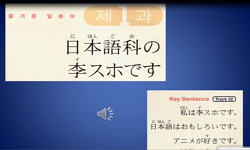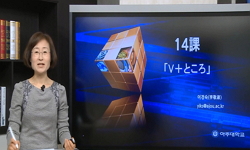The purpose of this study is to investigate personal pronouns in terms of hornorifics in modern Japanese. Personal pronoouns in other Indo-eruopean languages are rather simple compare to those of Korean and Japanese. Personal pronouns such as "watakus...
http://chineseinput.net/에서 pinyin(병음)방식으로 중국어를 변환할 수 있습니다.
변환된 중국어를 복사하여 사용하시면 됩니다.
- 中文 을 입력하시려면 zhongwen을 입력하시고 space를누르시면됩니다.
- 北京 을 입력하시려면 beijing을 입력하시고 space를 누르시면 됩니다.
https://www.riss.kr/link?id=T5697138
- 저자
-
발행사항
서울 : 建國大學校 大學院, 1985
- 학위논문사항
-
발행연도
1985
-
작성언어
한국어
- 주제어
-
KDC
751 판사항(4)
-
발행국(도시)
서울
-
형태사항
59p. : 삽도 ; 26cm
-
일반주기명
참고문헌: p. 56
- 소장기관
-
0
상세조회 -
0
다운로드
부가정보
다국어 초록 (Multilingual Abstract)
The purpose of this study is to investigate personal pronouns in terms of hornorifics in modern Japanese. Personal pronoouns in other Indo-eruopean languages are rather simple compare to those of Korean and Japanese. Personal pronouns such as "watakushi", "watashi", "boku", "ore" show a rather rich varieties in vocabulary as well as in its systems, and they don't make any inflections.
In this thesis the writer attempts to review particularly the relationship between personal pronouns and honorific structure of their meanings. Not only having demonstrative functions, but also they indicate speaker's judgement of honorific level towards his hearer. In this term Korean personal pronoun and that of Japanese are in common.
Some of the significant findings in this study were as follows:
(1) the first personal pronoun "watashi" is standard form in mordern Japanese. It can be used among male and female in common. However we find a strong tendency of using among female speakers generally. When a male speaker chooses "watashi" we may assume that the speaker talks or writes either to his elderly person or to his fellow. He usually does'nt choose it for indicating himself to his junior hearer. For instance, parents never call themselves as "watashi" in front of their children, they rather use the kinship terminologies such as "otoosang" or "okaasang" instead of "watashi". Again, an elderly person or a senior may call oneself as "sense" etc.
(2) The second personal pronoun "anata" seldom appears in Japanese sentences or in conversation. They prefer to abbreviate "anata". When they try to express honor to their speaker, they either abbreviate subject or they substitute for terminologies of social positions like "syachoo", "kachoo", "sensee". This is one of the characteristic difference between Japanese and Indo-europen languages. "Anata" may be said different from "you", and I may say this as "selectional restrictions of personal pronouns".
(3) The third personal pronoun "kare", and "kanojo" are not used for indicating elderly person. For the third person whom one, knows by name or by certain social position, the speaker prefers to call by name or by social position.
(4) Korean and Japanese show similarities in the sense that personal pronouns change in accordance with speech level.
(5) "watashi", "atashi" and "anata" are mainly used by female speakers. "boku", "washi", "ore", and "omae" are used by male speaker. So Korean learners of Japanese better be careful when they study, that the subject indicates female, then sentence ending has to be harmonized with it.
(6) When the system of "ko, so, a, do" is diverted to indicate personal pronoun, it means that speaker expresses his intention of honorifics to his hearer. This way of using demonstrative pronoun for indicating person, has been developed since early stage of middle Japanese.
When "kore" is used for person, it means that the subject of indication belongs to his inner circle such as one of his family member. By choosing demonstrative pronoun "ko, so, a, do", one may express his intention of modesty. But "are", "ano hito", "achira" may not be used for indicating elderly person. They usually indicate husband or fiance or his own children.
As is generally known, Korean and Japanese languages are quite similar in various syntactic structure. And here again, I would like to emphasize personal pronoun is a typical one.
목차 (Table of Contents)
- 目次
- Ⅰ. 序 = 1
- Ⅱ. 旣存硏究 = 4
- Ⅱ.1. 代名詞論 = 4
- Ⅱ.2. 人稱代名詞의 體系와 敬語體系 = 9
- 目次
- Ⅰ. 序 = 1
- Ⅱ. 旣存硏究 = 4
- Ⅱ.1. 代名詞論 = 4
- Ⅱ.2. 人稱代名詞의 體系와 敬語體系 = 9
- Ⅱ.3. 人稱代名詞의 변천 = 10
- Ⅲ. 人稱代名詞의 意味構造 = 14
- Ⅲ.1. 自稱代名詞 = 14
- Ⅲ.1.1. 「わたくし」와 「おたくし」 = 14
- Ⅲ.1.2. 「わたし」와 「あたし」 = 17
- Ⅲ.1.3. 「てまえ」 = 18
- Ⅲ.1.4. 「われわれ」와 「われら」 = 20
- Ⅲ.1.5. 「ぼく」 = 21
- Ⅲ.1.6. 「小生」과 「自分」 = 23
- Ⅲ.1.7. 「わし」와 「おれ」와 「おいら」 = 26
- Ⅲ.1.8. 「わが輩」와 「あつし」 = 29
- Ⅲ.1.9. 「こちら」와 「こつち」 = 30
- Ⅲ.2. 對稱代名詞 = 32
- Ⅲ.2.1. 「あなた」와 「あんた」 = 32
- Ⅲ.2.2. 「宅」와「お宅」 = 37
- Ⅲ.2.3. 「おまえ」 = 38
- Ⅲ.2.4. 「君」 = 41
- Ⅲ.2.5. 「貴榛, 貴兄, 貴君, 諾君」과 「うぬ, てめえ」 = 43
- Ⅲ.3. 他稱代名詞 = 45
- Ⅲ.3.1. 「彼」 = 47
- Ⅲ.3.2. 「彼女」 = 48
- Ⅲ.3.3. 「だれ」 = 49
- Ⅲ.3.4. 「どなた」 = 50
- Ⅲ.3.5. 지시어의 人稱代名詞的 用法 = 50
- Ⅲ.4. 呼應 = 52
- Ⅲ.5. 制約條件 = 54
- Ⅳ. 結語 = 55
- 參考文獻 = 56
- SUMMARY = 57












